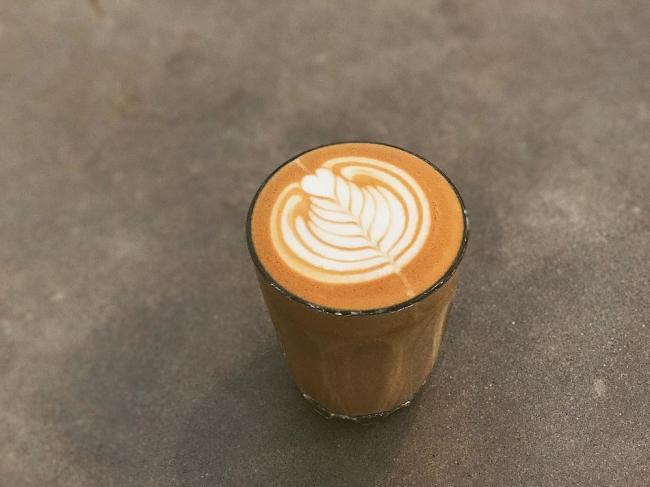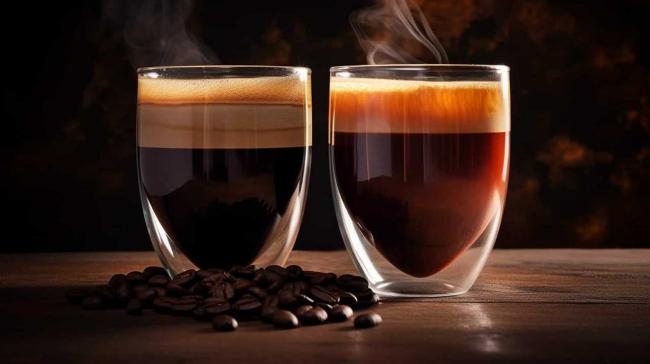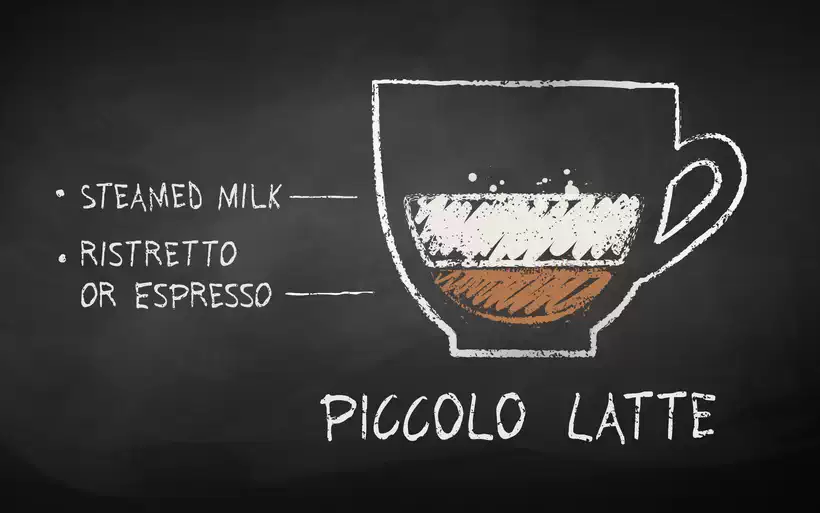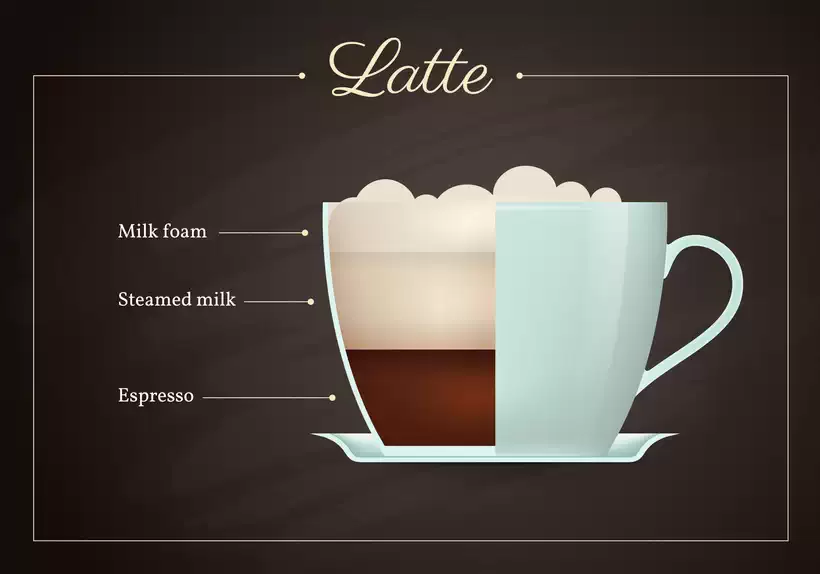Important Reminders While Brewing the Perfect Latte
I have already covered a few important precautions while telling you the recipe for this piccolo latte. Apart from those, there are a few other things about the piccolo latte that you must know, and I have highlighted those in this section:
- Grinding the coffee beans perfectly is the most important aspect of getting a fine espresso. A fine grind, commonly referred to as an , is the best for most brews with a powdery consistency.
- In piccolo, calories in a single serving are just 26- provided you use skimmed milk while making it. This makes your everyday cup (or cups) of piccolo latte a very healthy affair!
- Keep the wand clean, and wipe it off after every use. Before you steam milk, pulse the wand on and off a few times for freeing the duct off any particles.
- Pouring the milk is half of the task of making a latte. Ensure that you pour slowly, at a high distance and at an even rate. Give it time to allow the espresso and milk to incorporate.
How to Make Piccolo Coffee?
Piccolo coffee is a type of specialty coffee that is gaining popularity among coffee lovers. To prepare this delicious drink, you will need to follow the simple steps listed below:
- Start by grinding your coffee beans to the desired size, depending on your preferences. The typical grind for piccolo coffee is a medium-fine grind similar to what you would use for espresso.
- Next, heat up some water in your pot until it reaches the optimal temperature of 195 degrees Fahrenheit.
- Put a small amount of brewed coffee into each cup and pour in some hot water just to cover the coffee grounds.
- Give the coffee a gentle stir with a spoon or chopstick to ensure that all of the grounds are evenly saturated with water and then let the mixture rest for about 1 minute before stirring again.
- When done brewing, remove any excess foam from the top of the coffee and then enjoy your delicious cup of piccolo coffee!
If you love coffee, then you are sure to enjoy this deliciously aromatic drink. Whether you prefer yours black or with some milk and sugar, there is no doubt that piccolo coffee is a unique treat that you should definitely try at least once. So why not head down to your local coffee shop today and order yourself a nice hot cup of piccolo? You surely won’t regret it!
Espresso Machine and Steam Wand Method
If you don’t have the time or energy to visit your local cafe, you can make a piccolo at home. Alongside your milk of choice and coffee beans, this method requires you to have an espresso machine, shot glasses, a milk jug, a grinder, and a steam wand.
Start With a Shot of Espresso
The goal with piccolo coffee is to give you a balanced and rewarding blend of flavor, texture, and aroma. As such, make sure to measure out your coffee and milk so you can get the best possible result!
The base of a piccolo is a standard shot of espresso between 20 to 30 ml. You can adjust the amount according to your tastes, but we recommend starting with a single shot first.
Steam a Small Volume of Steamed Milk
You don’t need much milk to make a piccolo. Around 60 ml is the average amount needed to blend up your coffee without overwhelming the flavor.
Properly steamed milk should swirl during the steaming process, not bubble or froth up. While dairy milk is the standard, feel free to swap in a vegan substitute. Oat milk and soy milk are particularly good choices due to their creamier texture.
Tap and Swish
Once you’re done aerating your milk, tap your milk jug on the counter a few times to break up lingering bubbles. Follow this up with a little swish or two to keep your foam from separating.
Pour in Your Steamed Milk
Toss your shot into your glass or mug, then slowly pour in your steamed milk. Steamed milk should look creamy and stretchy, not fluffy and dry.
Dollop on Microfoam
If you’ve used the right volume of milk, you should only have a little microfoam left at the end. Dollop it on top and drink your piccolo as soon as possible!
The Piccolo Latte Recipe
Once you have the basic ingredients set, it is time to get started with putting this piccolo recipe to test and brewing your own delicious coffee!
Step 1: Get Some Freshly Roasted Coffee Beans
The first step to creating any delicious coffee drink is to get the right type of coffee beans. For a piccolo latte, you will need freshly roasted beans. These coffee beans are those that have been roasted for at least 4 days, and up to 3 weeks, prior to the day you use them in your coffee. Numerous online stores sell fresh beans as per these specifications, but if you want to inspect before you buy, then you can even hop into your local coffee shop for some advice.
When it comes to coffee beans, do not go with beans that have been roasted for over 3 weeks- the best flavor comes within the first 2 weeks, after which it begins to decline. There is no technology or packaging that can retain the flavor beyond this time.
Step 2: Prepare Your Espresso
Once you have acquired the perfect coffee beans for your piccolo latte, the next step will be preparing the espresso, which is one of the two important ingredients in the recipe. For the standard double shot, it takes around 18 to 21 of ground coffee, which means that you will approximately require around 60 grams of finely ground coffee. You can also grind coffee without a coffee grinder if you know how to do so. Getting the espresso ready will take around 30-40 seconds, and you should collect this in a small heated glass.
A Few Precautions in This Step Will Help You Get the Right Espresso:
- Your espresso is only as good as the water it is made with. Any sediments, scales or impurities will make the espresso undrinkable, so it is important to ensure that you are using good quality water before moving ahead.
- An espresso requires a finer grind as compared to other varieties. The coffee beans should clump together during the process, which is an indication that you are doing the right thing.
- Water with a temperature between 195º and 205ºF is the ideal ingredient for coffee. If you are not sure what to do here, let the machine do its job.
Step 3: Steam Your Milk
The next step is the same as any other latte- steaming the milk. Steam it along with a slight foam/froth texture. Before you steam the milk, ensure that you warp the steam using a clean and damp cloth for removing any water left in the sand. The entire wand tip should be covered by the surface of the milk. Steaming your milk properly is the key to getting the texture and appearance of the latte, and these simple precautions will help you get just that.
Step 4: Mix These Two
The next step involves pouring the milk into the glass that has the espresso. While this may seem like the easiest of them all, it is rather complicated and requires a lot of focus. Ensure that you pour the milk into the glass slowly. While pouring, the tip of the jug should be resting just inside the glass, not above or too much inside it. It will help the froth to slide out from the jug and get just on the top of the espresso. When done perfectly, you will get a layer of ½ inch thickness of the sweet-texture milk in your latte.
While you pour the milk, do not keep the pouring jug too high, as it could cause the milk to spill out a bit. Ensure that you do this step immediately after steaming the milk, within a few seconds. The hot milk will ensure that the espresso mixes in the perfect manner to create the taste expected from this piccolo recipe.
Step 5: Taste It!
And with this- you are done! Take a sip of that hot and refreshing latte to know that you have made the perfect piccolo latte. This latte is served hot- so for the best flavor and experience, you should enjoy it while the flavor lasts.
Top Tips For Making a Delicious Piccolo
Most importantly: how are you going to make your piccolo? The exact recipe is, as always, down to personal preference – but here are some tips to help.
To make a piccolo, extract a shot of espresso, between 20–30 ml. Steam your milk to around 60°C/140°F, allowing enough air into it to create some microfoam, but ensuring it’s stretched and silky. Pour between 40–60 ml of milk onto the espresso at a slight angle with a bit of height. This allows the milk to mix nicely with the espresso. To finish, allow a little room for a small layer of foam on top.
Choosing your coffee
Saša personally recommends opting for a coffee with “chocolate, hazelnut or caramel notes”. He advises against fruity coffees, since “with such a small amount of milk, they tend to be sour”.
Don’t be afraid to experiment a little to get the kind of flavour you want. Saša says that classic piccolo recipe of one shot of espresso topped with milk will create a bold and heavy flavour. However, if you want a bit more balance in the cup, he suggests “running a full shot of coffee, to get that nice and balanced coffee… 20–22g on each side… take out one-quarter of this, and then pour in the milk”. This should retain the intense espresso but result in a sweeter cup.

If you haven’t tried a piccolo before, now might be a good time to try. Got an espresso machine at home? You’re good to go. If not, speak to your barista, ask them to try the suggested piccolo recipe, and take it from there. The more the piccolo is enjoyed in its own right, the more we might see it in coffee shop menus.
There are so many different milk and espresso drinks to try, with their own delicious flavours. Yet the smooth yet punchy piccolo latte deserves a little limelight.
Enjoyed this? Check out our article on what a flat white is & where it came from.
Photo credits: Hany Ezzat, Neil Soque, Nathan Harradine-Hale for ONA Coffee
Perfect Daily Grind
Editor’s note: Some figures and information in this article were updated in March 2024.
Want to read more articles like this? Sign up for our newsletter!
Completing Special Events for Free Recipes
By participating in special events and completing tasks, players can earn free recipes for their cafe.

One way to unlock free recipes is by participating in seasonal events. These events are usually themed around holidays or special occasions and offer players the opportunity to earn exclusive recipes that are only available during that time. These recipes often incorporate seasonal ingredients and flavors, adding a festive touch to your cafe’s menu.
Another way to unlock free recipes is by completing hidden quests. These quests are often hidden within the game and require players to complete certain tasks or meet specific requirements. Once completed, players are rewarded with a secret recipe that can be added to their collection.
What is a Piccolo Coffee?
It doesn’t take long hanging around a true Italian coffee shop before you hear someone order a piccolo coffee. But what in the world are they ordering?
Piccolo means small in Italian. And a piccolo coffee is a small version of what you consider a standard café latte.
Piccolo coffee is a ristretto shot of espresso combined with steamed milk. Traditionally it’s served in a small 3 to 4-ounce glass.
In case you don’t know what a ristretto shot is, it’s basically a concentrated espresso shot. It will be much stronger tasting than standard espresso.
But the milk in the piccolo coffee helps balance the strong ristretto shot. This is why many people enjoy the flavor of piccolo coffee.
Factors Affecting Espresso Concentration in an Americano
Controlling the espresso extraction and adjusting the water-to-espresso ratio are key factors in achieving the desired concentration of espresso in an Americano.
When it comes to espresso extraction, several variables come into play. The grind size of the coffee beans, the pressure applied during extraction, and the brew time all have a significant impact on the concentration of the espresso.
A finer grind size will result in a stronger and more concentrated espresso, while a coarser grind will produce a milder flavor. Additionally, the quality of the coffee beans used plays a crucial role. Beans that are freshly roasted and of high quality will yield a more flavorful and concentrated espresso.
Advertisement
Frequently Asked Questions
What are the main differences between a Piccolo Latte and a Cortado?
A Piccolo Latte and a Cortado are both small espresso-based drinks served in small cups or glasses. The primary differences lie in their milk-to-coffee ratio, caffeine content, and taste. A Piccolo Latte typically contains one shot of espresso and more steamed milk, while a Cortado has two shots of espresso and less milk. As a result, a Piccolo Latte has a milder, creamier taste, whereas a Cortado has a more intense, slightly bitter flavor.
How does the caffeine content compare between the two drinks?
Due to the higher amount of espresso in a Cortado (two shots) compared to a Piccolo Latte (one shot), Cortado is naturally more caffeinated. Keep this in consideration when choosing your espresso-based beverage.
What is the origin of these drinks?
Both Piccolo Lattes and Cortados originated in Europe. A Piccolo Latte has Italian roots, while the Cortado finds its origins in the Spanish-speaking regions. Their growing popularity has now spread them across cafes and coffee houses worldwide.
How are the milk-to-coffee ratios different in these beverages?
In a Cortado the milk-to-coffee ratio is typically 1:2, meaning there is twice as much espresso as there is milk. In contrast, a Piccolo Latte has a 1:3 ratio, with three times the volume of milk compared to espresso. This ratio difference gives the Cortado a stronger, more espresso-forward flavor, while the Piccolo Latte offers a smoother, milkier taste.
Remember to keep these differences in mind when selecting your preferred coffee drink, and enjoy the unique flavors and textures each beverage offers.
Piccolo latte: Unveiling the Flavorful Elixir

If you’ve embarked on a journey through the world of coffee you might have encountered the captivating allure of the piccolo latte. This delightful variation of piccolo coffee holds a unique place in the realm of caffeinated beverages. Let’s delve into the fascinating world of the piccolo latte, exploring its origins, preparation, and the debate surrounding its flavor profile.
At its core a piccolo latte is a tantalizing blend of a ristretto shot and steamed milk harmoniously combined in a demitasse glass. The twist lies in the utilization of a ristretto shot a concentrated form of espresso extracted with a limited amount of water. This technique infuses the piccolo latte with an intense robust flavor that sets it apart from its espresso-based counterparts.
The ristretto shot not only enhances the flavor but also impacts the caffeine content. While the piccolo latte may have slightly less caffeine than a regular espresso its concentrated nature ensures a richer more flavorful experience. It’s an elixir that caters to coffee enthusiasts seeking a bold yet nuanced flavor profile.
But where did this exquisite concoction originate? The intriguing takes us to the vibrant coffee culture of Australia. It’s a tale of competing claims between two iconic Australian cities Melbourne and Sydney. Both cities assert their role in birthing the piccolo latte phenomenon.
Legend has it that baristas constantly sampling their coffee creations opted for piccolo lattes instead of full-sized lattes to gauge the nuances of their coffee roasts. This practice of sipping piccolo-style coffee gained traction leading to the emergence of the piccolo latte as a distinct choice. Its modest size and potent flavor captured the hearts of Australians spreading its charm across the country and eventually making its mark on the global coffee scene.
Intriguingly the piccolo latte is not just a coffee drink it’s a testament to the artistry of coffee-making. Its preparation involves a meticulous dance between the ristretto shot and steamed milk. The shot, pulled shorter than a regular espresso is carefully extracted into a demitasse glass. Meanwhile around 80ml of milk is steamed to the consistency of a latte. The two elements are then combined with the milk poured into the glass at an angle, allowing them to mingle in perfect harmony.
In conclusion the piccolo latte stands as a symbol of coffee craftsmanship and innovation. Its fusion of a ristretto shot and velvety milk offers a symphony of flavors that tantalize the palate. Originating from the passionate coffee culture of Australia it has earned a rightful place in cafes around the world. So the next time you seek a coffee experience that transcends the ordinary indulge in the delightful and flavorful world of the piccolo latte.
Frequently Asked Questions
Can I make a Piccolo Latte or Cortado at home without an espresso machine?
While an espresso machine is ideal, you can use a strong brew from a Moka pot or Aeropress as an alternative for the espresso component in both drinks.
Are there dairy-free versions of these drinks?
Absolutely! You can substitute the dairy milk with almond, soy, oat, or any other plant-based milk to suit your dietary preferences.
Can I adjust the sweetness of these drinks?
Yes, you can add sugar or a sweetener of your choice, though traditionally these drinks are enjoyed without added sweetness to appreciate the coffee’s natural flavors.
Как кортадо называется в других странах
Рецепт топленого кортадо на данный момент – очень популярный и дорогой напиток в мире. Правда, в разных странах его называют по-разному:
Нуазе – во Франции.
Кортадито на Кубе.
Пинго или гарото в Португалии.
Эбак – в басконской области Испании.
Тайат – в другой части Пиренейского полуострова – Каталонии.
Везде кортадо стоит дорого, потому что для его приготовления используется приготовленное специально топленое молоко. Это занимает время – более 8 часов
Вдобавок, чтобы получить нужный вкус, важно использовать цельное домашнее молоко с высокой жирностью, так как вкус дает именно молочный жир, подвергшийся длительной тепловой обработке
What is a Piccolo coffee?
The taste of coffee in every cup of piccolo coffee is noticeable.
Fact:
Piccolo means small in Italian. Some baristas would even call the piccolo drink a piccolo latte or piccolo espresso, which is basically a small milk beverage.
Now, the name of this drink may be Italian, but piccolo coffee is actually created in Australia.
The piccolo allegedly rose to prominence in Australia ten years ago and is said to have originated in Sydney. Piccolo coffee is said to have been invented by baristas to keep enjoying their coffee throughout the day.
The size and amount of ingredients keep you from going over your dairy and caffeine intake.
The piccolo is a single ristretto shot topped with milk and served in a 90ml glass. Simply put, more coffee (+++), less milk (-).
The single ristretto shot is topped with steamed, stretched milk, allowing it to blend with the coffee. Finally, the piccolo coffee is topped with a small amount of foam. This allows the espresso flavor to shine through without being overpowering.
Aside from piccolo, Australia is also known for its magic coffee. Like piccolo, magic coffee is also made with ristretto and is a bit similar to a latte.
If you don’t feel like having a large latte and a quick caffeine fix that isn’t too strong, you can also try “Magic coffee.”
This is another Australian beverage that originated in Melbourne cafes. It is also harder to find magic on the menus. Wait, in fact, you won’t find it on the menus of Melbourne cafes.
The magic is served in a 5oz or 160ml cup with a double ristretto and steamed milk with little to no foam.
What does Piccolo coffee taste like?
The single-shot piccolo is mild, sweet, and delicate.
Piccolo latte is just another name for piccolo coffee. It is made in exactly the same way.
You might find its appearance to be like a small latte. But because a latte has one part coffee to two parts milk, You’ll notice that a piccolo has a stronger flavor.
If you want to go stronger with your latte, you’d have to start with the espresso shot and add a dollop of milk froth as you would for a piccolo.
Fact:
Piccolo coffee is simply an abbreviation for piccolo latte coffee. A piccolo latte is a freshly roasted coffee made up of a single shot of ristretto. It is served in a demitasse glass and topped with latte-like steamed milk.
So piccolo coffee is like a cross of other coffee drinks. It can be confused with a macchiato, flat white, or a cortado. Heck, some coffee shops are even confused!
Let’s compare it with other similar drinks, shall we?
Similar Coffee Drinks
Macchiato
The macchiato is a popular choice among coffee connoisseurs for its rich, bold espresso flavor, delicately balanced with a small amount of steamed milk. This coffee drink starts with a shot of espresso, followed by a dollop of frothed milk on top. Since it contains a smaller amount of milk compared to other coffee drinks, the macchiato’s dominant flavor comes from the espresso, making it ideal for those who prefer a more robust, concentrated taste.
Cappuccino
Cappuccino is a popular coffee beverage, recognized for its balance of espresso, steamed milk, and frothy milk foam. It is typically created with equal parts of each element: one-third espresso, one-third steamed milk, and one-third foam. This harmonious combination of flavors and textures creates a smooth and creamy experience, loved by many coffee drinkers around the world.
Flat White
Originated in Australia and New Zealand, the flat white has gained popularity in recent years due to its perfect blend of bold espresso and creamy, velvety milk. The flat white begins with a shot of espresso, followed by steamed milk, resulting in a decadent coffee creation. The key difference between a flat white and a cappuccino is the absence of foam on top of the flat white. The absence of foam allows the espresso’s flavor to shine through while still enjoying a lusciously creamy texture.
Cafe Latte
The cafe latte, or regular latte, is another popular coffee beverage that combines a shot of espresso with steamed milk, creating a rich and smooth experience for those who desire a more mellow alternative to stronger, more concentrated coffee drinks. A cafe latte typically contains more milk than a cappuccino, making its overall taste smoother, slightly sweeter, and more indulgent.
In conclusion, all these coffee drinks offer distinct flavors and textures for a variety of preferences. Whether you are looking for a bold and intense flavor, like the macchiato, or the smooth and creamy taste of a cafe latte, there is a coffee beverage that caters to your desired coffee experience.
How To Make A Good Piccolo Coffee?
Okay, reading about Piccolo latte has piqued your interest but you can’t find it in your local coffee shop?
Don’t worry. You can make one right in the comfort of your home.
First, make sure you have a 4oz cup ready.
Next, make a shot of Ristretto using your espresso machine. Use the same amount of coffee as you would for an espresso shot, but use only half the amount of water. Your Ristretto shot should be around 15 to 20ml. Pour that into your 4oz cup.
Now, you have to make your steamed milk. You will be needing around 85ml of steamed milk to go on top of your Ristretto shot. Once your warm milk is ready, slowly add it on top of your Ristretto shot.
Do add a small layer of foamed milk or milk foam to make it look beautiful.
If you have a 4oz glass, then that would make it even better.
This Piccolo recipe is not the only way to make Piccolo coffee. The basics are the same so don’t hesitate to make improvisations as you might end up with a better Piccolo on your hands.
Also Read: Is Chai Latte Coffee?
Health Benefits of Drinking Piccolo Coffee
It is widely acknowledged that coffee has been linked to a plethora of health benefits. Here are some of the health benefits that you may reap by imbibing piccolo latte.
Rich in Antioxidants and Nutrients
Piccolo coffee is a profuse source of antioxidants and nutrients that can aid in safeguarding your body from the detrimental effects of free radicals. Antioxidants function by reducing inflammation and oxidative stress in the body, which in turn can decrease your likelihood of developing chronic ailments such as cancer and heart disease. Furthermore, it encompasses imperative nutrients such as vitamin B2, B3, and potassium, which can bolster your overall health and well-being. ()
Boosts Brain Function and Metabolism
Piccolo latte encompasses caffeine, a natural stimulant that can aid in enhancing brain function and metabolism. Caffeine operates by hindering the inhibitory neurotransmitter adenosine, which can uplift your mood, concentration, and reaction time. Furthermore, caffeine can facilitate the escalation of metabolism and fat burning, making it a great component to incorporate into a healthy diet and exercise routine.
Helps Reduce Risk of Chronic Diseases
Consuming piccolo latte on a habitual basis has been linked to a reduction in the likelihood of developing chronic diseases such as type 2 diabetes, liver disease, and Alzheimer’s disease. This is primarily due to the antioxidants and nutrients found in coffee that can aid in protecting the body from damage and inflammation. Additionally, the caffeine present in this cup of joe can also aid in augmenting insulin sensitivity and mitigating the risk of type 2 diabetes. ()
In summary, incorporating this type of coffee into your daily routine can potentially bestow a variety of health benefits. From safeguarding the body from damage caused by free radicals to enhancing brain function and metabolism, piccolo coffee may be a simple and enjoyable way to promote overall health and well-being.
Difference Between a Piccolo Latte and a Latte
Although they may appear similar, there are marked distinctions between a piccolo latte and a regular latte. Some of these differences are explained below.

Size
A piccolo latte is served in smaller cups with typically 100 ml capacity. On the other hand, regular lattes come in larger cups or glasses of around 240 ml or more.
Coffee-to-Milk Ratio
A piccolo latte consists of one ristretto shot (15-20 ml) topped with steamed milk and microfoam; this creates an intense yet balanced flavor profile due to its higher concentration of espresso compared to milk volume.
In contrast, a standard latte features one full espresso shot (30ml) combined with steamed milk and froth, resulting in a milder taste as it has more milk diluting the coffee’s strength.

Frothing Technique
For a piccolo latte, the goal is to create a velvety microfoam with tiny air bubbles that blend seamlessly with the espresso.
In comparison, traditional lattes feature larger froth bubbles on steamed milk, creating a lighter mouthfeel and allowing for more elaborate latte art designs.
Which Coffee Beans Are Best Used for This Recipe?
A medium to dark roasted bean with a rich, full-bodied flavor profile works well for a piccolo latte to bring the perfect balance.
Arabica and Robusta coffee beans are often used in this espresso-based beverage. Arabica beans tend to be more delicate with nuanced flavors, while Robusta beans offer a stronger taste with higher caffeine content.
Additionally, medium-roasted coffee beans are ideal for this espresso beverage. Light roasts typically offer brighter acidity and more pronounced fruity or floral notes, while dark roasts bring out deeper flavors like chocolate, caramel, or nuts. Thus, medium roasts strike a balance between these two extremes.
Tips for Achieving the Ideal Espresso Balance in Your Americano
We can achieve the ideal espresso balance in our Americano by experimenting with different coffee-to-water ratios and adjusting the brewing time to suit our taste preferences. Here are some tips to help you achieve the perfect flavor and coffee extraction in your Americano:
-
Coffee-to-water ratio:
-
Start with a ratio of 1:16 (1 part coffee to 16 parts water) and adjust according to your preference.
-
Increase the coffee-to-water ratio for a stronger and more intense flavor, or decrease it for a milder taste.
-
Brewing time:
-
Shorter brewing time (around 20-30 seconds) will result in a lighter and less bitter taste.
-
Longer brewing time (around 30-40 seconds) will give you a stronger and more robust flavor.
How To Make Piccolo Coffee?
Piccolo is a smaller version of a latte, the overall best way to extract the flavors and strength it has to offer without having to much acidity longer extractions give. Here’s how to make it!
1. Place the 3oz/90ml glass – directly underneath the espresso machine, these glasses are half the size of a regular latte
2. Extract one ristretto shot- pull the ristretto between 18 – 22 seconds, or 15 – 20ml of liquid, into the glass. Always use fine grind, whether its your own coffee beans or buying espresso at a store. Never use coarse grinds
3. Start steaming your milk – traditionally, dairy milk is used, and steam up to 60°C/140°F. Enough air should be introduced, creating micro foam. Remember, smaller glasses are used, so not much is needed
4. Pour 40 – 60ml of steamed milk onto the espresso – be sure to pour at an angle, and slightly above the glass. This will help you with better control and consistency
5.Next, add micro foam – easiest way to do this is with a spoon, leaving room for a small layer of micro foam ontop
Tips: If your planning on latte art, fill the glass 2/3 before starting. This will help the design
Advertisements
Conclusion
In the world of specialty coffee, the piccolo latte and cortado reign as popular choices for those seeking smaller, espresso-forward beverages. Both drinks share similarities in their origins and components, yet each offers a unique flavor profile and experience.
The piccolo latte, hailing from Italy, is composed of a single espresso shot coupled with steamed milk, typically served in a demure 3-4 oz glass. This concoction results in a delicate balance between the bold espresso and the smooth, subtle flavor of the milk. Fans of the piccolo latte praise this combination for enhancing their overall coffee encounter.
On the other hand, the cortado, originating in Spain, is centered around a more robust, espresso-driven experience. Featuring two shots of espresso and a 1:2 ratio of espresso to milk, the cortado boasts a bolder coffee taste. With less milk than its piccolo latte counterpart, the cortado’s flavors tend to be more pronounced and suited for genuine espresso aficionados.
To summarize, both the piccolo latte and the cortado cater to distinctive preferences among coffee enthusiasts. The piccolo latte, with its delicate balance of espresso and milk, may appeal to those who appreciate a smoother, milder beverage. Conversely, the cortado, with a more prominent presence of espresso, may satisfy the palates of die-hard coffee devotees. Ultimately, it’s up to individual preferences when deciding which diminutive coffee masterpiece to indulge in.
That Coffee Craving
Caffeine is addictive, which is another reason why people drink coffee. Caffeine is one of many chemicals in coffee that contribute to its addictive properties. Caffeine withdrawal can produce headaches and irritation; therefore, many individuals would rather not stop drinking coffee. Switching to decaffeinated coffee can help those that merely enjoy the taste of coffee but do not want to consume too much caffeine.
Coffee drinkers claim that it helps them relax. While this may seem contradictory given that coffee is a stimulant, a hot cup of coffee (normal or decaf) can help people relax their senses and settle their anxieties. The relaxing effect is attributed to the stimulation of the senses, which benefits creativity and mental stimulation, according to researchers.
Tips on How to Make the Best Piccolo Coffee at Home
Making a perfect piccolo at home is easy. The secret is to use the right equipment. Follow these simple steps and enjoy the best Australian coffee experience.
- Use the right grind size: Aim for a grind size of about 2-4 on a burr grinder.
- Use the right coffee amount: Piccolo has a ratio of 1 part coffee to 2 parts water.
- Use the proper water temperature: Use water between 195 degrees Fahrenheit and 205 degrees Fahrenheit when making this coffee. This is the ideal temperature range to extract the most flavor from the coffee grounds.
- Use the right brewing vessel: Use a small, single-serve espresso machine or a stovetop espresso maker.
- Refrain from over-extracting the coffee: Stop brewing when it reaches its desired strength. Over-extracting the coffee can result in a bitter, unpleasant taste.












